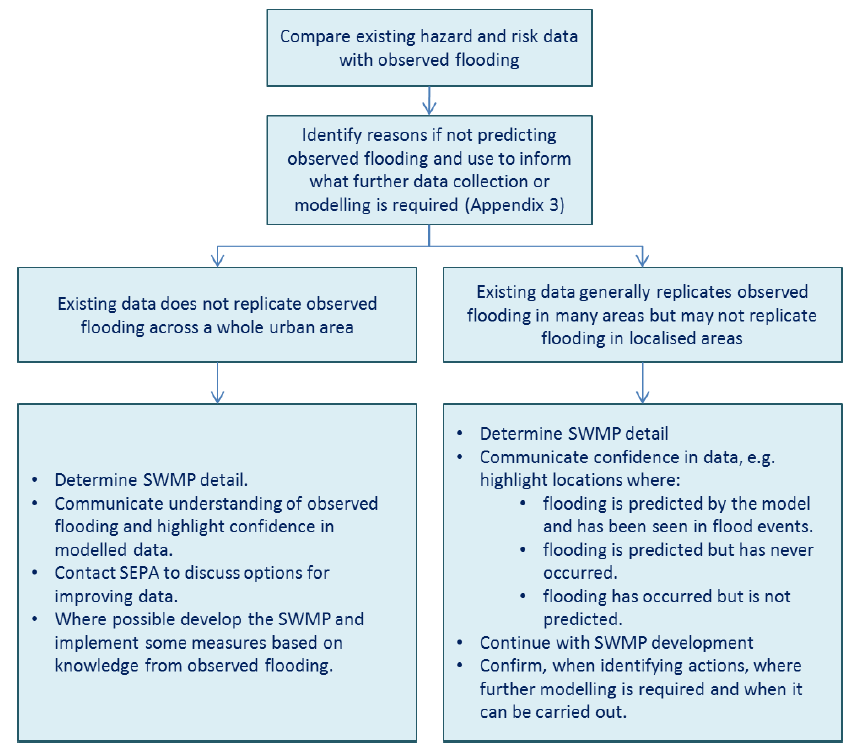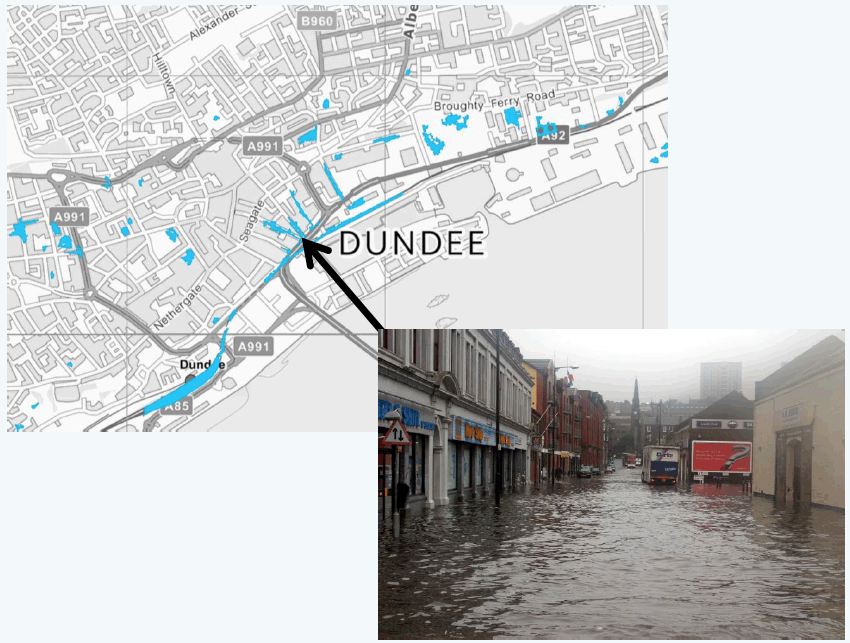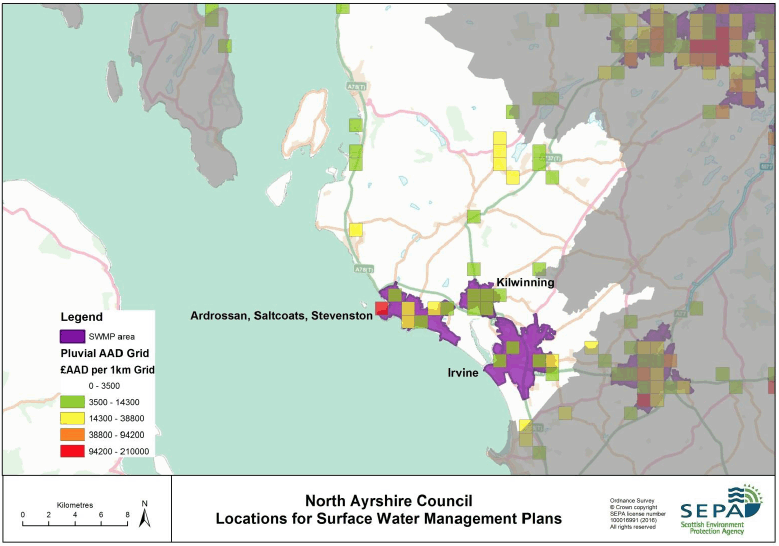Surface water management planning: guidance (2018)
Guidance to assist the responsible authorities in preparation of Surface Water Management Plans (SWMPs) to help with the management of surface water flooding.
4 Preparatory work
| Preparatory work: considerations and example outputs | |
|---|---|
| Considerations | Example outputs |
|
|
4.1 Resources for developing the surface water management plan
The first consideration for a local authority is likely to be what resources it will need to develop the SWMP. Decisions on funding and implementing actions identified through the surface water management planning process will be made at a later stage.
Consideration of the resources needed to develop the SWMP should include:
- The spatial scale of the SWMP – does the LA require an SWMP for the whole LA area, focusing more detail on SWMP areas identified in the FRM Strategies, or will it simply focus on the SWMP areas in the FRM Strategies?
- The level of detail required for each stage of the SWMP (see Section 4.5), for example:
- Understanding flood risk: how much analysis of existing data and what outputs are required?
- Setting and prioritising objectives: what outputs are required and how much consultation is needed when prioritising?
- Identifying actions: what type of appraisal will be carried out, e.g. high-level appraisal of actions for all objectives that could be carried out over the long term, or more detailed appraisal and design for priority objectives?
- Whether there are opportunities for resource-sharing with other local authorities, e.g. if developing SWMPs for more than one LA area.
- Whether the LA has sufficient in-house resources or will need to appoint consultants.
- If consultants are appointed, for what stage(s) of the SWMP development or implementation are they needed.
4.2 Governance, consultation and co-ordination
Governance
The local authority leading on the surface water management planning process should establish internally the governance needed for agreeing the SWMP. This may include governance for:
- Agreeing what actions to implement, funding and implementation of actions.
- Establishing which local authority will lead the SWMP(s), if more than one is involved.
- Links to the Local Plan District partnerships to feed outputs from the SWMP into FRM Strategies and LFRMPs.
- Legal agreements or memoranda of understanding, should the lead authority require more formal partnerships with other authorities. (Time to compile these should also be factored into the process.)
Consultation and co-ordination at the preparatory stage
Further information on consultation and co-ordination is given in Chapter 3, but at this preparatory stage the main considerations include:
- Identifying which stakeholders to consult. As a minimum, they should include drainage, flooding and planning authorities:
- LA flooding ( SWMP lead).
- LA roads.
- Scottish Water.
- LA land use planning.
- Establishing when to consult them and at what stage each stakeholder’s input is required.
- Deciding how stakeholders will be consulted, e.g. through informal, information-sharing meetings or more formal partnerships.
- Making sure that initial consultation with stakeholders:
- Includes an introduction to the SWMP process, and details on how and when their views will be sought.
- Identifies relevant information held by the key authorities and ways of sharing it. This stage should focus on information that helps to improve understanding of surface water flood risk (see Section 4.3 below), but eliciting information from stakeholders on potential opportunities for co-ordinating actions can also begin here.
- Recognising that consultation requirements may change as the SWMP develops. For example, it may be useful to consult other individuals/partners or to introduce more formal arrangements at the implementation stage.
4.3 Collating existing information on surface water flood hazard and risk
SWMPs should be based on the best available information. Maximum use should be made of the relevant data and information held by various authorities. Much of the data will be subject to licensing requirements so timescales for securing access should be taken into account. Key information is listed below but other information may be available:
SEPA data
Strategic flood hazard and risk (adverse impacts of flooding) data. At the time of publication the SEPA 2013 pluvial hazard and risk data was available and had been shared with local authorities:
- Regional pluvial hazard and risk
- National pluvial hazard and risk
- Pluvial AAD (annual average damages) 1km grid
- Pluvial flood map confidence dataset
- Information on flood events.
(The above information is also available for fluvial and coastal flooding)
LA flooding data
May have more detailed surface water hazard and risk data (e.g. Scottish Water and local authority Integrated Catchment Study ( ICS) models)
- Models of watercourses and culverts
- Topographic surveys
- Information on flood events
- Information on existing surface water management structures
- Information on other assets, e.g. culvert locations and surveys
- Maps of SUDS (sustainable urban drainage systems) and watercourses.
LA roads data
- Information on road drainage infrastructure
- Information on flood events.
Scottish Water data
- Flood hazard from the sewer system (Section 16 assessment)
- Other sewer network drainage information (e.g. ICS models, other sewer network models)
- Information on drainage infrastructure (e.g. information on sewer flooding, combined sewer overflows, current and future infrastructure improvements)
- Information on flood events (internal and external sewer flooding registers).
Scottish Government
- Flood disadvantage information and maps ( http://www.gov.scot/Topics/Environment/Water/Flooding/resources/research)
Public
- May have local knowledge about flood events.
A data register should be set up to record the information available for the SWMP area. The register should include information on:
- What data and information is available.
- Who owns the data/information.
- Licensing information, including any potential limitations on using the data (e.g. what data can be made publicly available and how data can be used by consultants).
- The format of the data and information.
- The level of confidence in the data and its suitability for use.
4.4 Validating existing hazard and risk information
Before developing an SWMP it is important to understand how much confidence can be placed in the existing information. This is done by validating the models with observed flood events. The result will determine what the information can be used for, what decisions it can help to inform and how much detail can be assessed at each stage of the SWMP. It will also help to clarify whether more detailed modelling or other information is required. The SWMP should explain clearly what data is being used and what confidence can be put in it.
A summary of how to use key data appropriately during the surface water management planning process is given below:
SEPA regional pluvial flood hazard and risk data
At the time of publication the SEPA 2013 regional pluvial data was available.
There is higher confidence in the regional pluvial data than in the national pluvial data from SEPA. Hence it is generally expected that where there is good validation with observed events, the regional pluvial hazard maps and associated regional pluvial risk should be appropriate for the following tasks:
- Understanding flood hazard and flood risk.
- Understanding some flooding mechanisms (will show flooding from overland flow and possibly from small urban burns, but not flooding from culverts, sewers or interactions between sources, e.g. above- and below-ground interactions or river and sea interactions with drainage infrastructure).
- Identifying neighbourhoods in towns and cities with greater flood risk (flooding hotspots).
- Establishing more detailed objectives for surface water flooding.
- Identifying actions (long list).
- Conducting a strategic cost-benefit appraisal of actions (structural and non-structural).
SEPA national pluvial (hazard and risk data)
At the time of publication the SEPA 2011 national pluvial data was available.
Areas where there is no regional pluvial hazard mapping are covered by the national pluvial hazard mapping. It is undertaken using a coarser type of pluvial modelling and can provide some supporting information for local authorities not covered by regional pluvial modelling. It may be appropriate for identifying towns and cities at greater risk of surface water flooding. It is not likely to provide detail on which neighbourhoods within towns and cities are at greater risk and may not be appropriate for identifying more detailed objectives. Thus the types of actions that can be identified from this data are limited.
Scottish Water flood risk from sewerage systems (Section 16)
Scottish Water’s assessment of flood risk from sewerage systems (under Section 16 of the FRM Act) shows flooding locations, volumes and extents from the sewer network. When used in conjunction with the regional pluvial flood hazard and risk mapping and local knowledge, it can provide further insight into likely flood sources and mechanisms.
In many cases this information can be used in SWMPs without the need for further modelling. In others, further modelling and new hazard and risk mapping may be required or warranted, e.g. for locations with lower confidence in the data where existing information does not match observed events, or to carry out detailed appraisal and design of actions. In such cases, SEPA can provide data to make further hazard modelling and risk mapping relatively straightforward (and consistent with national flood risk assessments), using a variety of different modelling platforms (software) and methods. The need for more detailed modelling can be identified as an action in the SWMP; it does not need to be completed for progress on the SWMP to continue.
Responsible authorities may have other relevant information, which should be used where available to inform the SWMP.
Figure 4.1 shows the validation process (see Appendix 3 for further information). The process can also be used with other modelling, e.g. more detailed modelling that an LA has carried out, modelling from integrated catchment studies and Section 16 assessments.
Further information on pluvial flood hazard modelling can be found in SEPA’s flood modelling guidance [5] and the regional pluvial hazard mapping methodology. [6]

Figure 4.1 Flood hazard and risk data validation process
The first step is to compare modelled flooding with observed flooding.
The regional pluvial hazard maps show a range of modelled scenarios. Initially the 1:50 year regional pluvial flood extent should be compared with local records of flooding and other anecdotal information about the location and frequency of previous flooding. The 1:50 year pluvial flood extent is used as a starting point because it should represent rainfall events that have been experienced, as opposed to rarely occurring, larger magnitude floods (e.g. 1:200 year). It should be used where the drainage system is unlikely to have a major impact on flooding. Comparing results using smaller return periods may help to identify areas where better representation of the drainage system is required to reproduce the flooding mechanism correctly.
There is no reliable, scientific way to compare historical and modelled flooding; therefore, all SWMP stakeholders should apply their judgment. The model should be validated against known flooding locations. Alignment (or failure of alignment) between modelled flooding locations and flooding observations is likely to be a combination of:
- Locations where flooding is predicted by the model and has been observed – good alignment between observed and modelled flooding locations is the ideal, even if predicted flooding is not matched by observations elsewhere. Where there is good alignment between modelled and observed flooding locations, and the flooding mechanisms are understood, then higher confidence can be placed in the modelled data.
- Locations where flooding is predicted but has never occurred – in this case the model may be accurate but there has been no flood event to validate it in the given location. Just because a location has not experienced flooding in the past does not mean that it is not at risk of flooding in the future. It is more difficult to determine confidence in a model if there are no observed events to validate it.
- Locations where flooding has occurred but is not predicted – in this case the model is failing to predict the observed flooding and further information or investigation is likely to be required.
It is likely that for an urban area the SEPA regional pluvial modelling may be more accurate in some locations and less so in others. This should be acknowledged when summarising the impacts of flooding and identifying locations at greatest risk. More detailed modelling for those localised areas where information is less accurate could then be identified as an action in the SWMP.
Failure to replicate known flooding locations across a wider urban area indicates the need for further modelling at a more strategic scale in order to represent flood mechanisms correctly. If this is the case, the matter should be discussed with SEPA in order to determine the most appropriate way forward.
The second step, if the modelled flooding is not predicting observed flooding, is to identify possible reasons for this by applying professional judgment. This will then inform what further data collection/modelling is required (see Appendix 3 for further information). To identify possible reasons why a model is not replicating observed flooding it is important to confirm the data and parameters used in the existing model. For SEPA’s regional pluvial modelling, the pluvial confidence data can provide this information. For example, the digital terrain model ( DTM) used can have a significant impact on the modelling and not all SEPA’s regional pluvial modelling is based on the most accurate DTM ( LiDAR).
Box 4.1 Validation of modelling in Dundee
Validation of SEPA’s pluvial flood hazard map in the Trades Lane area of Dundee shows a good match between modelled and observed flooding. The flooding that was observed in the Trades Lane area in August 2004 is successfully predicted by the model.

Comparison of modelled flood extents and observed flooding in the Trades Lane area of Dundee.
Photograph courtesy of ©DC Thomson & Co.
4.5 Scoping the level of detail
All stages of the SWMP process should be risk-based. The level of detail to go into at each stage (e.g. the number of outputs and detail provided in each) will be influenced by a number of factors, including: the level of flood risk, the complexity of the flooding problem, the resources available and the availability and confidence in existing data.
To give two examples:
- A relatively simple SWMP with lower flood risk may have more informal information-sharing fora with stakeholders, one relatively short report summarising the findings of each stage (including data to share with stakeholders) and a smaller range of objectives and actions.
- Larger urban areas at greater risk of surface water flooding and with complex problems may have more formal consultation arrangements, closer partnership working, numerous outputs (e.g. technical reports supporting different stages, a more detailed SWMP report for implementation and a summary SWMP report for other stakeholders, and other data for sharing with stakeholders), plus a larger range of objectives and actions.
4.6 Defining SWMP geographical areas
SWMPs can be carried out on any geographical scale, adopting a risk-based approach and focusing more detail on areas assessed as being at greatest risk. For example, an SWMP could be carried out for an entire LA area while focusing in greater detail on SWMP areas identified in the FRM Strategies (and any other areas of interest to the local authority). Or, a larger urban area could be covered by many SWMPs.
Defining an area allows flood risk information to be summarised for that area, allowing the level of flood risk to be monitored over time to determine whether the objectives of reducing flood risk and avoiding a rise in flood risk are being met (see example in Figure 4.2).
The following factors should be considered when defining the SWMP area:
- Where the greatest impacts of surface water flooding occur – the SWMP boundary does not limit where actions can be implemented to manage surface water flooding, e.g. there could be storage or land management upstream of an SWMP area. Nor does the area have to include all the sources and pathways of surface water flooding, although they should be considered.
- The extent of urban areas – a good starting point is the National Records of Scotland information on Settlements and Localities. GIS layers showing these spatial boundaries are available on its website: http://www.nrscotland.gov.uk/statistics-and-data/geography/our-products/settlements-and-localities-dataset.
- The size and extent of natural drainage features – for example, watercourses and their catchments, culverts and topography.
- Sewer catchment boundaries and other artificial drainage networks – it should be noted that artificial and below-ground drainage networks do not always drain the areas defined by natural topography.

Figure 4.2 North Ayrshire Council locations for surface water management plans based on National Records of Scotland settlements data.
Contact
Gordon Robertson: Flooding_Mailbox@gov.scot
There is a problem
Thanks for your feedback